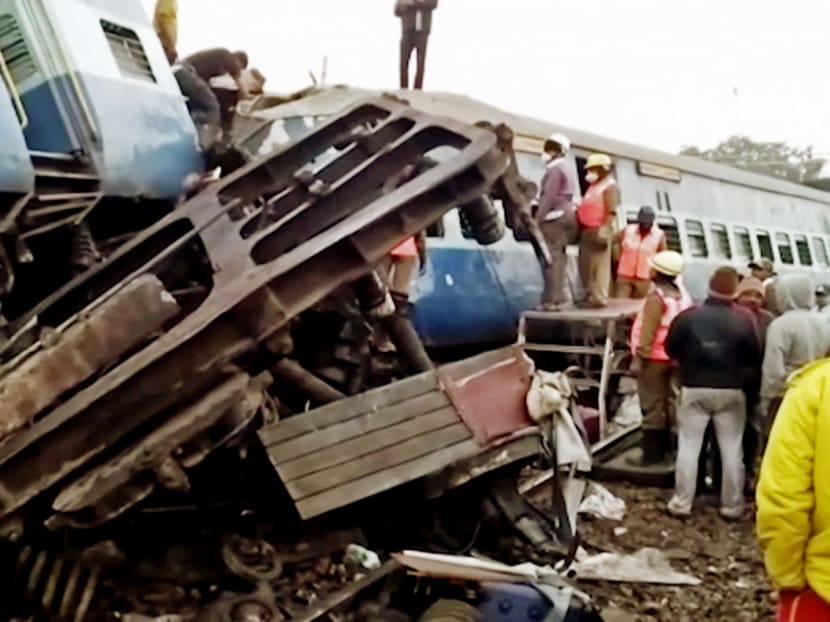India turns to tech in bid to improve rail safety
NEW DELHI — India is phasing out the daily track inspections conducted by an army of 125,000 engineers across its vast colonial-era railway network, as ministers attempt to put an end to the blight of deadly derailments.

India’s train system has experienced several deadly derailments, with the most recent, in Andhra Pradesh last month, killing 41 people. The sector is turning to technology in a bid to update its infrastructure and improve safety. Photo: AP
NEW DELHI — India is phasing out the daily track inspections conducted by an army of 125,000 engineers across its vast colonial-era railway network, as ministers attempt to put an end to the blight of deadly derailments.
A plan to bring in electronic sensors on tens of thousands of kilometres of track instead is part of a wider programme to improve railway safety, to which Finance Minister Arun Jaitley allocated US$15 billion (S$21.2 billion) in last week’s Budget, and follows three serious derailments in the past three months.
“We will be using wheel-based sensors and fixed monitors at certain positions on the track to measure whether they are fractured,” said Mr Hanish Yadav, an adviser to Rail Minister Suresh Prabhu. He added that the sensors would take several years to install.
India’s rail system is one of the largest in the world, carrying 20 million passengers a day. But it is also in need of modernisation, with many parts of its infrastructure more than 100 years old.
Even where improvements are being made, the technology updates often lag well behind those in Western countries. The Linke-Hofmann-Busch coaches being rolled out to replace older trains, for example, were designed in the 1990s.
The problems with the system have been highlighted in recent months after a series of serious accidents in which dozens of people died. The most recent, last month, involved a passenger train coming off the rails near the border between Andhra Pradesh and Odisha in eastern India, killing 41 people.
Sabotage has not been ruled out for any of the accidents. However, local officials have said there is no evidence of deliberate attacks, and civil servants blame decades of under-investment for the state of the system, in which tracks regularly fracture.
“In over 65 years (since independence), there was no money to be spent on new technology,” said Mr Yadav. “With the money they had, the best they could do was simply to maintain their assets.”
Mr Prabhu has pledged US$137 billion until 2020 to overhaul the system, as part of a plan that includes attracting private-sector money and foreign investment to help rebuild stations and implement new services. Two years in, however, the results of that scheme are mixed.
Of the 400 stations across the country that are due to be upgraded, only a handful have been approved. Of these, only one is designed by a private company, a model the government hopes to encourage.
Another idea, to tap foreign markets for funds using “masala bonds” issued in London, has fallen by the wayside. “We were not able to get better rates than we could domestically,” said Mr Yadav. Masala bonds are bonds issued outside India, but denominated in Indian rupees.
The ministry’s plans to electrify and broaden thousands of kilometres of track appear to be behind schedule. According to an internal strategy document seen by the Financial Times, about 5,000km of track is overdue for renewal.
Meanwhile, an eye-catching project to build a US$15 billion high-speed link between Mumbai and Ahmedabad has been signed off by the Japanese and Indian governments, but New Delhi is yet to allocate its US$2.7 billion portion of the funds needed to build it.
“Unfortunately, the current government is focusing more on mega-projects like the bullet train rather than upgrading the current infrastructure,” said Mr Sandeep Upadhyay, chief executive of Mumbai-based Centrum Infrastructure Advisory.
However, he added that passengers would start seeing improvements more quickly over the next few years.
“The root cause of all our problems has been that there was not enough money to invest in capital infrastructure,” he said. “But now, for the first time, the money is being made available to do that. Now we have to get on with spending it.” FINANCIAL TIMES





